Smith & Wesson’s introduction of the Response 9mm Carbine is an exciting addition to their lineup, offering shooters a lightweight and versatile pistol-caliber carbine (PCC). While the company’s FPC (Folding Pistol Caliber Carbine) has been successful as a compact and portable option, the Response carbine is designed for a different role, delivering enhanced handling and precision for home defense, competition and recreational shooting.
Design and Features
The Response shares an AR-style design with controls that will feel intuitive to anyone familiar with the AR-15 platform. This carbine features a straight blowback operation for simplicity and reliability, a polymer upper and lower receiver and an adjustable stock. Weighing in at just under 6 pounds, the Response is light yet sturdy, making it easy to maneuver in tight spaces or during rapid-fire drills.
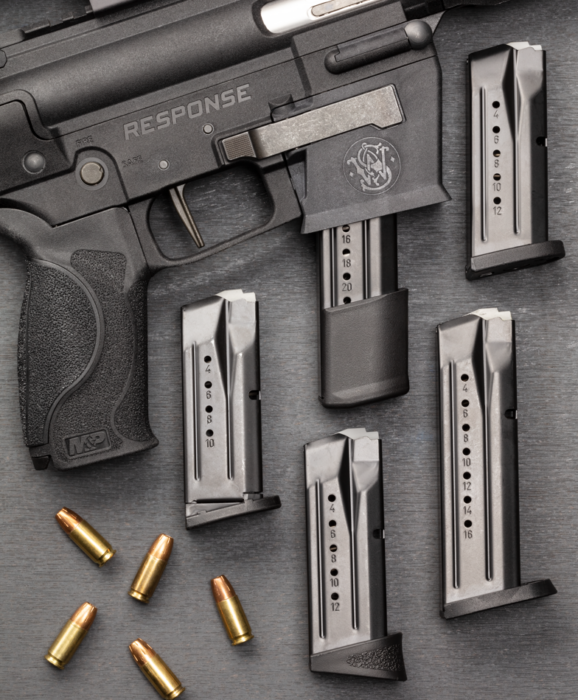
It comes equipped with a 16.5-inch threaded barrel (1/2-28 threads), perfect for a suppressor, an M-LOK handguard for accessory mounting and interchangeable grip inserts borrowed from Smith & Wesson’s Military & Police pistol series. The carbine is configured out of the box for Smith & Wesson M&P pistol magazines and includes two 23-round metal magazines. For added versatility, it features an easily swappable adapter to accommodate Glock magazines.
Performance and Shooting Impressions
Out of the box, the Response proved fast and accurate. The flat-faced trigger, breaking at a crisp 4 pounds, provided excellent control and a positive reset. For testing, I mounted a TruGlo PR 1 red-dot sight that offered a clear, illuminated aiming point ideal for both defense and sporting use.
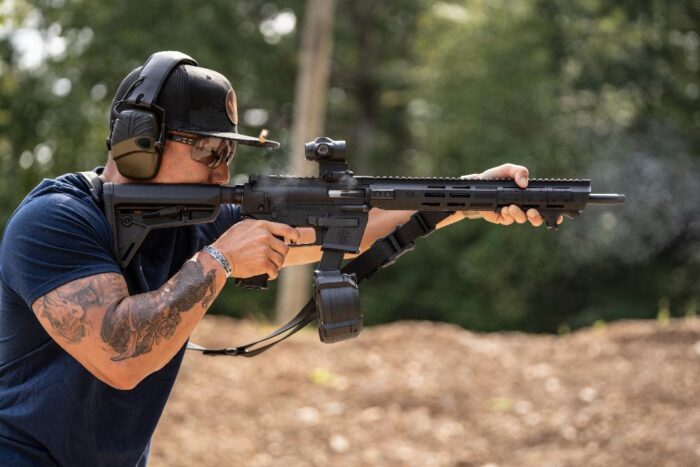
At the range, the carbine performed flawlessly, feeding and firing various loads without issue. Using Black Hills 115-grain FMJ for initial testing, the Response demonstrated impressive accuracy at close- to mid-range distances, with tight groupings at 10, 15 and 25 yards. Recoil was minimal, making follow-up shots fast and easy.
A move to an outdoor range allowed for 50-yard testing with defense-oriented loads. Despite the limitations of pistol-caliber ballistics at longer distances, the Response delivered consistent five-shot groupings, ranging from 1.9 to 2.6 inches.
50-Yard Accuracy Results
| Load | Group Size (5 Shots) |
|---|---|
| Black Hills 115 gr. EXP | 2.5 in. |
| Black Hills 124 gr. JHP | 1.9 in. |
| Black Hills 125 gr. Honey Badger | 2.25 in. |
| Handload 124 gr. XTP | 2.5 in. |
| Handload 115 gr. Sierra JHP | 2.6 in. |
Practical Considerations
The Response is ideal for home defense, offering ease of use for shooters of all skill levels. Unlike handguns, which require significant training to master, and most importantly, to hit what a person is shooting at, a carbine like the Response is inherently easier to handle, with greater accuracy and reduced recoil. It also provides the advantage of higher ammunition capacity and increased stability for easier aim.
For competition or pest control, the carbine performs admirably within its effective range. However, for hunting or shooting at distances beyond 100 yards, a .223 or other rifle-caliber firearm would be a better choice.
The 9mm cartridge doesn’t benefit as significantly from a carbine-length barrel as rounds like the .357 Magnum or 10mm, but the velocity increase is still valuable, typically adding 100 to 200 fps. Some have raised concerns that bullets designed for pistol velocities might expand too quickly when fired from a carbine, but testing shows this is rarely an issue. In fact, most 9mm loads demonstrate increased penetration—typically an additional two to three inches—along with slightly greater expansion at carbine velocities. Modern bullet designs, such as the Hornady XTP and Federal HST, are engineered to maintain integrity at higher speeds. Black Hills’ excellent projectiles serve as a prime example of this reliability.
Final Thoughts
Smith & Wesson’s Response 9mm Carbine combines lightweight construction, excellent ergonomics and reliable performance in a well-rounded package. Whether used for home defense, competition or recreation, the Response delivers on every front. Its compatibility with both Smith & Wesson and Glock magazines adds a layer of versatility that few carbines can match.
While the FPC remains a great option for portability, the Response offers enhanced precision and handling, making it a worthy addition to any firearm collection. For shooters seeking a reliable PCC, the Smith & Wesson Response is well worth considering.

Specifications
- Caliber: 9mm
- Action: Semi-Auto, Blowback
- Barrel Length: 16.5 in., threaded 1/2-28
- Overall Length: 32 1/8 in. to 35 3/8 in.
- Weight: 5.9 lbs.
- Capacity: 23+1
- Stock: Adjustable
- Handguard: M-LOK
- Receivers: Polymer
- MSRP: $799
Where to Buy
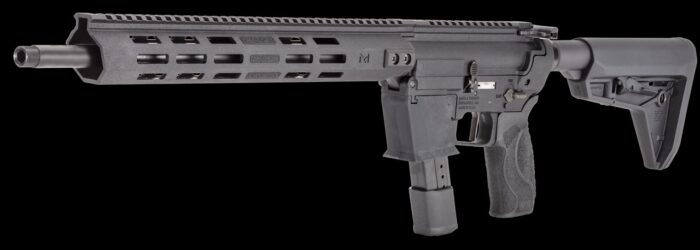
Check out Ammo To Go, the ammunition retail sponsor of TTAG.
Product and gun reviews are performed independently and product mentions made based on the quality of the product and value of interest to gun owners. However, when you buy through links on our site, we may earn a commission to help support the costs of operating the site and keeping it free for our visitors.

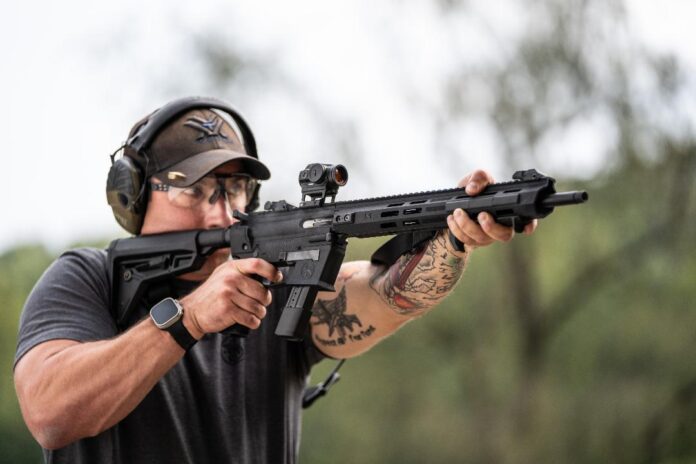
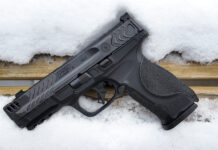


Meh
It looks fine, but I don’t see much point to it.
It is the size and cost of a standard AR-15. For a 9mm carbine I’d rather have something smaller, lighter, and more portable like my Sub2k, the folding S&W carbine, or an arm braced AR pistol with an 8-10″ barrel. With a full sized 16″ AR, I’ll just stick with 5.56.
that’s a bingo.
The only Reason I could see having a P.C.C is to save on the cost of ammunition. The 9mm is certainly less expensive than 556/223.
I could afford the 556. So I bought the 556 rifle.
Would also add the limited involvement firearm owners that bought a Glock for Covid riots and kinda wants a rifle but doesn’t want to bother with different ammo/mags. Basically an offshoot of your version but lazy instead of broke.
Yeah, I forgot about that. Ammunition magazine compatibility between handgun and rifle.
Just like the Cowboys wanted to have the same caliber for their handguns and lever action rifles.
I believe that new Henry semi-auto rifle takes glock magazines.
It comes out of the box with Henry’s magwell and a 5-rounder. Glock and either SW or Sig (forget which) adapters are sold separately for about $25-30 each. The 10 round Henry mags are hard to come by and online scalpers have them for $50 each or more. A customer came in looking for one. With his agreement we ordered him a Glock adapter and sold him two $20 Magpul Glock mags, saving him at least 30 bucks over ordering two Henry 10ers.
Chris T in KY,
Pistol caliber carbines offer three distinct advantages for home defense:
1) Ammunition is less expensive.
2) Children can handle lightweight carbines.
3) They produce FAR LESS blast versus rifle calibers.
Those last two advantages can be huge, especially if you do not have a suppressor to reduce blast. Many people can tell you that shooting a carbine chambered in .223 Remington / 5.56x45mm NATO inside a home is deafening–literally. Shooting a carbine chambered in 9mm Luger indoors, while still very likely to cause hearing loss, is an order of magnitude less harsh.
As mentioned above, a lightweight carbine (such as the Kel-Tec SUB-2000) is something that children can handle, both in terms of handling (not having too much weight too far forward) as well as recoil. Needless to say, a handgun is out of the question in terms of a home defense firearm for many/most children.
Off the top of my head, I imagine that most children age 11 and up can handle a pistol-caliber carbine. I cannot say the same for a 7-pound AR-15–especially for children who are smaller than average.
I remember cerakoting one of these for a customer. The construction is in the style of HK’s .22LR MP5/AR lookalikes, with metal insert assemblies inside the polymer shells. So where it counts most, the parts are good aluminum and steel. The barrel and upper receiver shell don’t use the traditional barrel nut, so rather than risk damage separating them I taped the barrel off and did them as a unit.
CK’ing polymer is more challenging than metal because it soaks up more of the paint, requiring more passes to get full coverage and increasing the risk of “orange peel” (unwanted texturing from blowing around the accumulated paint). Fortunately the already rough surface of this gun’s polymer and the metallics in the customer’s desired color helped disguise any small mistakes I may have made.
Where are the .45ACP (or 10mm) versions S&W? Just poodle shooters.
Pretty sure a few versions of both are floating around now. ACP doesn’t really benefit much from the extra barrel but 10 is neat.
Never thought much of the PCC concept. SMG? Sure. They are more compact and versatile. If I’m carrying something with a 16″+ barrel it’s going to chamber a rifle cartridge.
Same. I’d think a shortened barrel (think AR pistol) in perhaps 9″ length would be better for 9mm. If a full 16″, then better to go with a cartridge designed for it.
As an aside…from the article:
“Some have raised concerns that bullets designed for pistol velocities might expand too quickly when fired from a carbine,…”
An additional 200 fps would lend additional kinetic dump (stopping power) to the target, so I’m not sure why anyone would be concerned about expansion. I’d rather be concerned about *under* expansion than *over*.
I think the real reason to get one of these is a companion pistol. otherwise hard to see much differentiation. That said the price is probably not bad for an ar9.
I will say +p ready would he nice.
Finally getting into chronographs so hoping to get some readings on various oddballs especially in the sub 90 grain wrights.
my favorite loads involved Blue Dot in my AR9s. does almost nothing extra in pistols though.
Noted, I do wonder how much overlap I will see between light and average bullet weights with powders that show improvement with more barrel length.
By the way I really hate it when someone produces an AR-15 inspired pistol-caliber carbine and keeps the huge magazine well with a stupid insert to properly orient small magazines.
If you are designing a pistol-caliber carbine from the ground up, lose the stupid huge magazine well.
Note: I understand standard AR-15 conversions to a pistol caliber where someone slaps a pistol caliber upper on a standard lower–those require a magazine well insert. That is different than designing a pistol-caliber carbine from scratch and keeping the huge magazine well for no obvious reason.
Beretta was pretty good with putting together various 9mm rifle options especially when sbr can be done in the state.
@uncommon,
That was the very first thing I noticed as well, looking at the photo before even reading the article.
Agreed. Gives off the vibe of a little kid trying on Daddy’s coat.
so, 4moa? not bad.
I hate to say it but I’ve never seen what I’d call stellar performance from my AR9. I always wonder if it’s just the barrel or my reloads (then again I’ve tested factory ammo too) but I don’t ever really see anyone doing much better.
uncommon sense SW offers the FPC to the specs you would desire.
The Response is supposed to be AR like, hence the magazine well.
The fact is – it works, reloads are very fast and the piece is reliable.
SW simply covers all the bases
Thank you for the additional information.
The S&W FPC has everything I want in a pistol caliber carbine plus portability. I put a Holosun red dot on mine, and that thing is a tack driver at PCC ranges. I almost couldn’t believe it; that thing is magic.